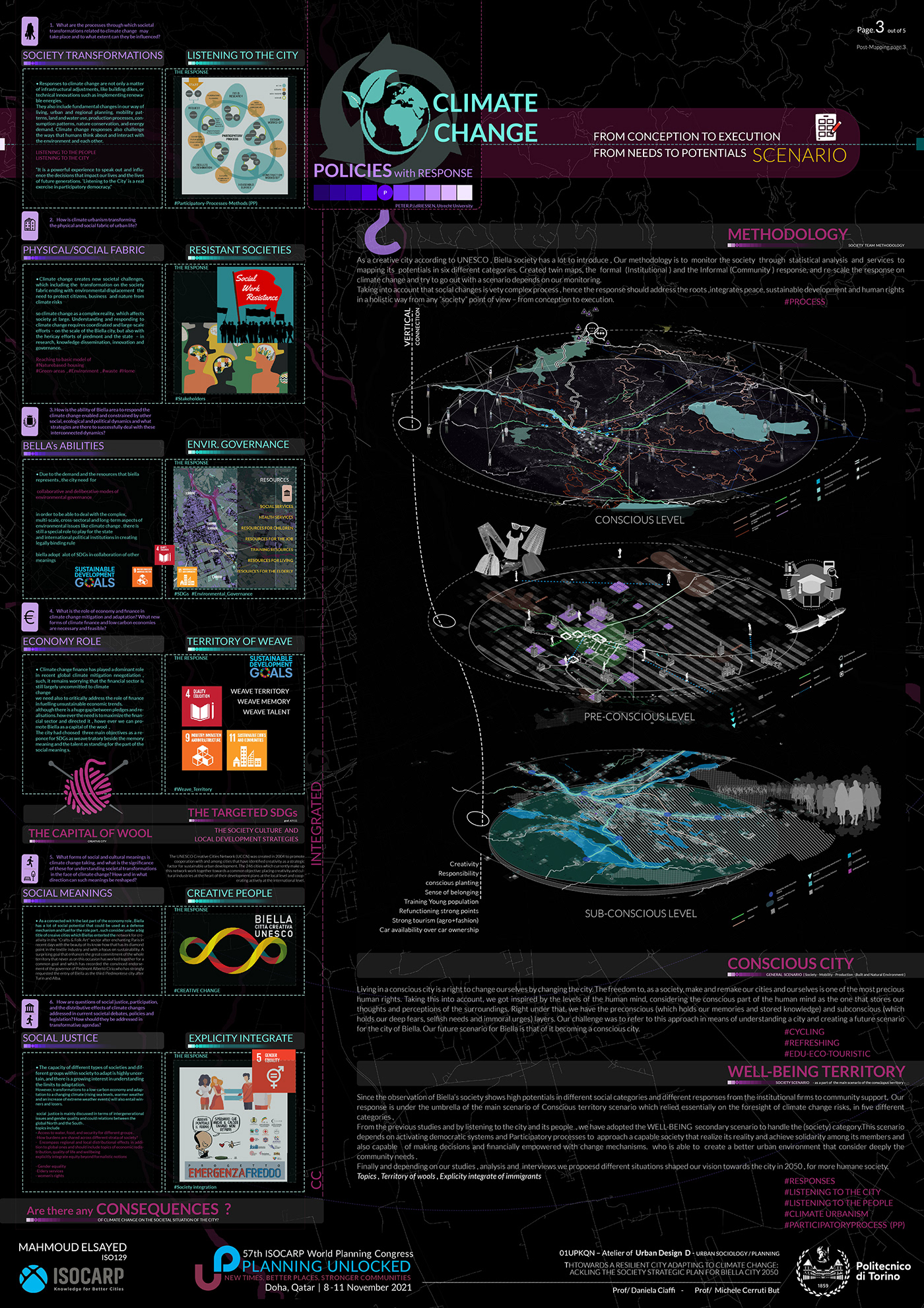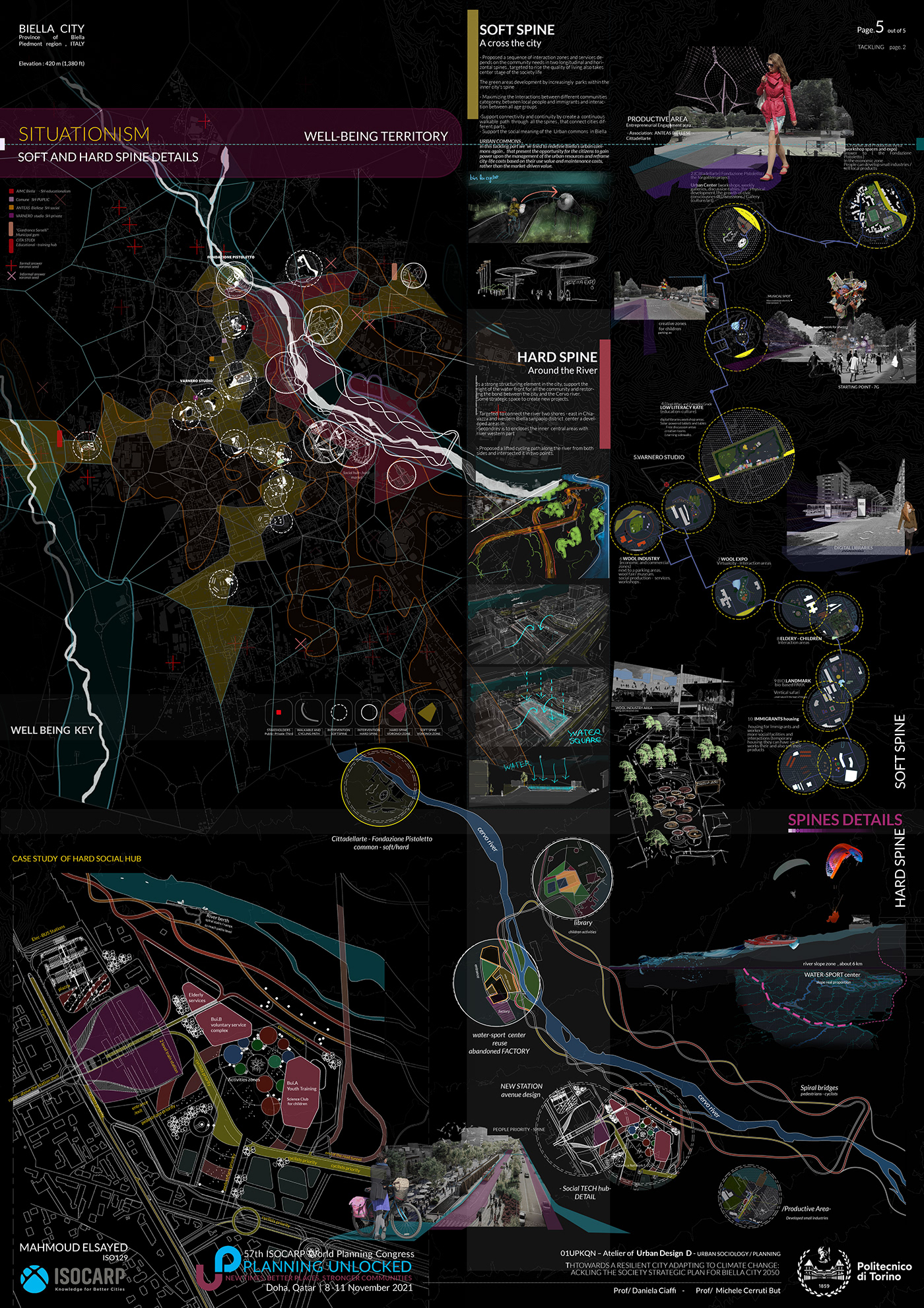Delighted and proud to participate as a speaker at the 57th ISOCARP - International Society of City and Regional Planners congress held in Doha. NOV 2021
With my academic contribution developed at Politecnico di Torino, titled :
( Towards a resilient city adapting to climate change: tackling the society strategic plan for Biella city 2050 as a Climate urbanism case -Northern Italy)
,Track 4 : Al-Waha : promoting glocal solutions.
Grateful also to be among these effective communities of planning and built environment , taking serious steps parallel with #COP26 summit in Glasgow to face climate change…
All efforts combined can make a difference.
THE RESEARCH PROJECT PANELS :
سَعيد و فخور بمشاركتي كمُتحدث في الدورة ال 57 للمؤتمر الدولي لمُخططي المُدن و الأقاليم , جاءت مشاركتي بعنوان ( نحو مَدينة مرنة تتكيف مع التغير المناخي , معالجة المخطط الاستراتيجي لمُجتمع مدينة بيلا كحالة مناخية حضرية - شمال ايطاليا ) . المشروع جاء في المسار الرابع للمؤتمر: الواحة ( تعزيز حلول محلية-عالمية ).
مُمتن لتواجدي وسط هذا المُجتمع الفاعل في قضايا التخطيط و العُمران و التي تَحدث تزامنا مع مؤتمرالامم المتحدة للمناخ COP26 بجلاسكو.
كل الجهود مُتضامنة يمكنها أن تُحدث فارقا …
التصميم الخاص بالمشروع

TITLE :
Towards a resilient city adapting to climate change: tackling the society strategic plan for Biella city 2050 as a climate urbanism case , Northern Italy
ABSTRACT
Biella is a name of a city and a capital of the province of the same name, it forms a complex territory which has been considered as the cradle of the industrial revolution in Italy, inherited urban and social values which promoted the city now to defined as a creative city mainly with the luxury wool fabrics in northern Italy, Piedmont region. Climate change CC creates new societal challenges which affect the transformation of the society fabric ending with environmental displacement, because of, the whole socio-cultural-economic world has already affected the way that our cities perform not just the environment, we have to go forward from sustainable urbanism to climate urbanism to achieve real livable places and resistant societies. This shift is characterized by new policies, programs aimed to, considering climate alterations as a present condition instead of a future hazard and seeking to the actual implications on the case study of Biella’s Society, with the influence of built environment, Natural environment, Economy, and mobility, started by mapping the climate change potential effects through this approaches then tackling it through a systemic approach developing comprehensive spatial and infrastructure response with the aim of evolving new models of living together, finally to promoting the horizontal metropolis as a proper site of climate action instead of running local policies based on centers – peripheries narratives! Inspired by Freud, the Levels of consciousness represent in three different layers, the conscious level consists of all the things we are aware of, including things we know about ourselves and our surroundings. The pre-conscious consists of things we could pay conscious attention to if we so desired and is where many memories are stored for easy retrieval. Freud saw the pre-conscious is composed of thoughts that are unconscious at the moment in question, but available for recall and easily capable of becoming conscious. The unconscious level consists of things that are outside of conscious awareness, including many memories, thoughts, and urges of which we are not aware. Much of what is stored in the unconscious is thought to be unpleasant or conflicting. While these elements are stored out of our awareness, they are nevertheless thought to influence our behavior. By the three levels of inspiration, and through a dense interview with different stakeholders and representatives of the public, private and third sector, the project moved forward with an AI tool to the real needs and the accurate spatial positions by verification what we called “formal and informal” different responses in collaboration with climate change response of the whole territory. The interventions were highlighted to achieve a (well-being society), passing from (welfare society) as a very different concept since the works on individual and collective engagement and commitment, an advance translation targeting a resilient society that adapt also with the circumstances of CC, to develop a (well-being) spaces, buildings, livable built environment on the city mainly by listing to the people, which serve different communities and help them to interact and sympathize, also to have a role in activating the democratic and participatory meanings. By connecting the urban nodes and achieving thriving public spaces for all society layers such as playful, learning spaces for children, active areas for adults, interaction areas for elderlies, helping to create a resistant society against the hazards, focusing on heritage place, smart culture, tourism places, urban connectivity places,.. etc, taking in consideration the required SDGs of the city as a territory of wool and set recommendations for collaborative and deliberative modes of environmental governance.





